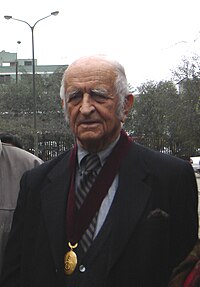
If required I can bring more information about this artist FERNANDO de SZYSZLO Fernando De Szyszlo Valdelomar (born July 5, 1925 in Lima) is a Peruvian artist who is a key figure in advancing abstract art in Latin America since the mid-1950s, and one of the leading plastic artists in Peru. Studies and influences Szyszlo studied at the School of Plastic Arts of the Pontifical Catholic University of Peru. At the age of 24 he traveled to Europe where he studied the works of the masters, particularly Rembrandt, Titian and Tintoretto, and absorbed the varied influences of cubism, surrealism, informalism, and abstraction. While in Paris he met Octavio Paz and André Breton and frequented the group of writers and intellectuals that met regularly at the Cafe Flore engaging in vigorous discussions on how they could participate in the international modern movement while preserving their Latin American cultural identity. Upon his return to Peru, Szyszlo became a major force for artistic renewal in his country breaking new ground by expressing a Peruvian subject matter in a non-representational style. He was married to a Peruvian poet Blanca Varela, with whom he has two children. 



At the age of 24 he traveled to Europe where he studied the works of the masters, particularly Rembrandt, Titian and Tintoretto, and absorbed the varied influences of cubism, surrealism, informalism and abstraction. While in Paris he met Octavio Paz and Andre Breton and frequented the group of writers and intellectuals that met regularly at the Cafe Flore engaging in vigorous discussions on how they could participate in the international modern movement while preserving their Latin American cultural identity. Upon his return to Peru, Szyszlo became a major force for artistic renewal in his country breaking new ground by expressing a Peruvian subject matter in a non-representational style. Lyricism of color enriched by rich textural effects and a masterly handling of light and shadow are hallmarks of Szyszlo's painting. Highly identified with the linking of ancient cultures to a modernist artistic language, Szyszlo's art reflects a broad culture that draws on many sources from philosophy and science to literature 
|